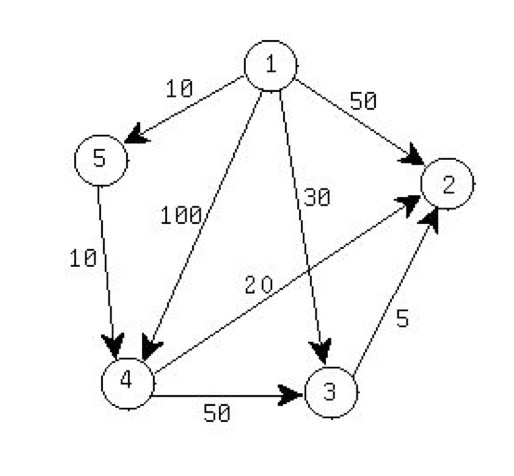Pseudo Code for Dijkstra's Algorithm
Adjacency Matrix Version
Determining the Shortest Paths from a Single Start Node to All Other Nodes

INPUT: An n x n matrix EdgeLength, which represents a directed graph G with n nodes.
The names of the nodes are 1, 2, ..., n. Node 1 is the start node. EdgeLength[i][j] = zero
if i=j. If i ≠ j, and if an edge of G exists from node i to node j,
then EdgeLength[i][j] = the length of the edge. If i ≠ j, and there is no edge in G from
node i to node j, then EdgeLength[i][j] = INF, a special value that is larger than the sum
of all the lengths of all edges in G.
OUTPUT: Two 1 x n matrices, Dist and BackPoint.
- Dist[1] = 0, and BackPoint[1] = 1.
- If i ≠ 1, and if there is a path in G from node 1 to node i, then
- Dist[i] is the length of a shortest path from node 1 to node i, and
- BackPoint[i] is a node j such that j-->i is the last edge
in a shortest path from node 1 to node i.
- If i ≠ 1 and if there is NOT a path in G from node 1 to node i, then
- Dist[i] = INF, and
- BackPoint[i] = 1.
THE PSEUDO-CODE:
/* S is the set of nodes reached so far */
Initialize a set C = {2, 3, ... , n} ; /* C is the complement of S */
For i from 1 to n
{
Initialize Dist[i] = EdgeLength[1,i] ; /* the matrix top row */
Initialize BackPoint[i] = 1 ;
}
/* The greedy loop */
Do n-2 times
{
ν = some element of C with smallest value of Dist[ν] ;
/* The 'magic' of the algorithm is that Dist[ν] is
now the length of the shortest path from 1 to ν
(or INF, if there's no path from 1 to ν). */
C = C-{ν} ; /* Delete ν from C } */
/* Check for better paths that use ν. */
For each ω in C such that there is an edge ν-->ω
{
If Dist[ω] > Dist[ν] + EdgeLength[ν,ω]
Then
{
Dist[ω] = Dist[ν] + EdgeLength[ν,ω] ;
BackPoint[ω] = ν ;
}
}
}
Return Dist and BackPoint as the output ;

